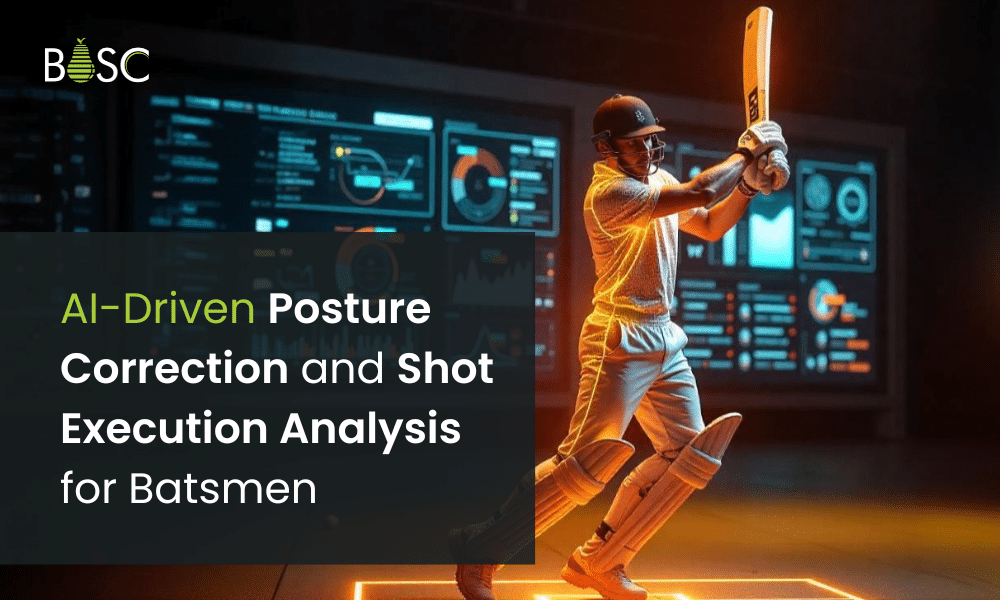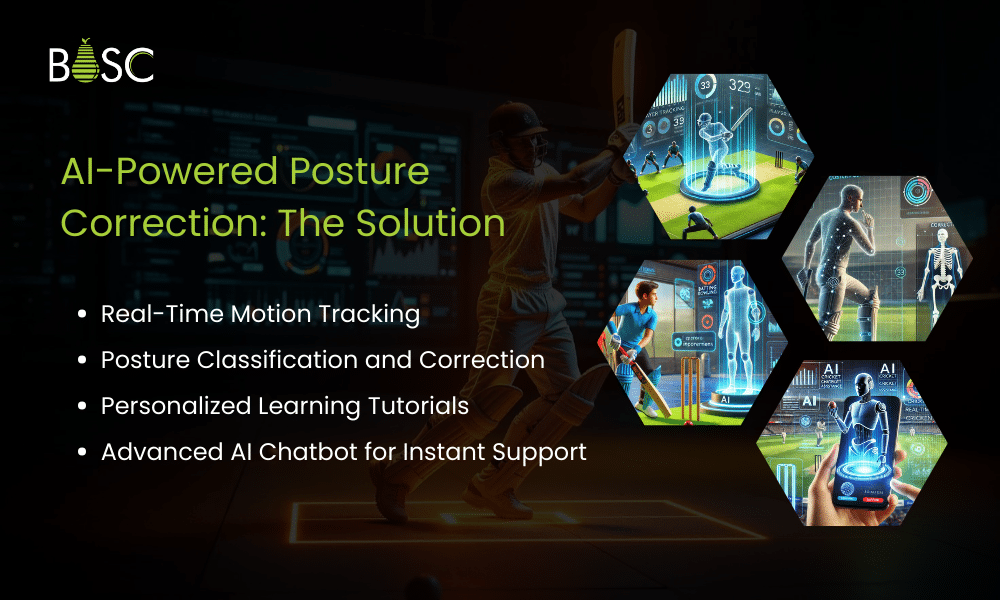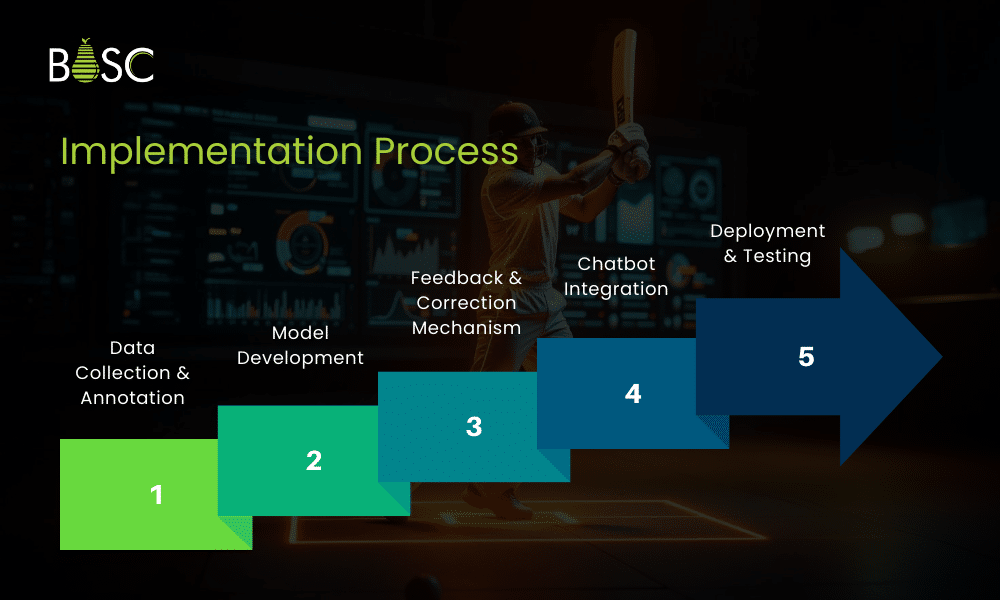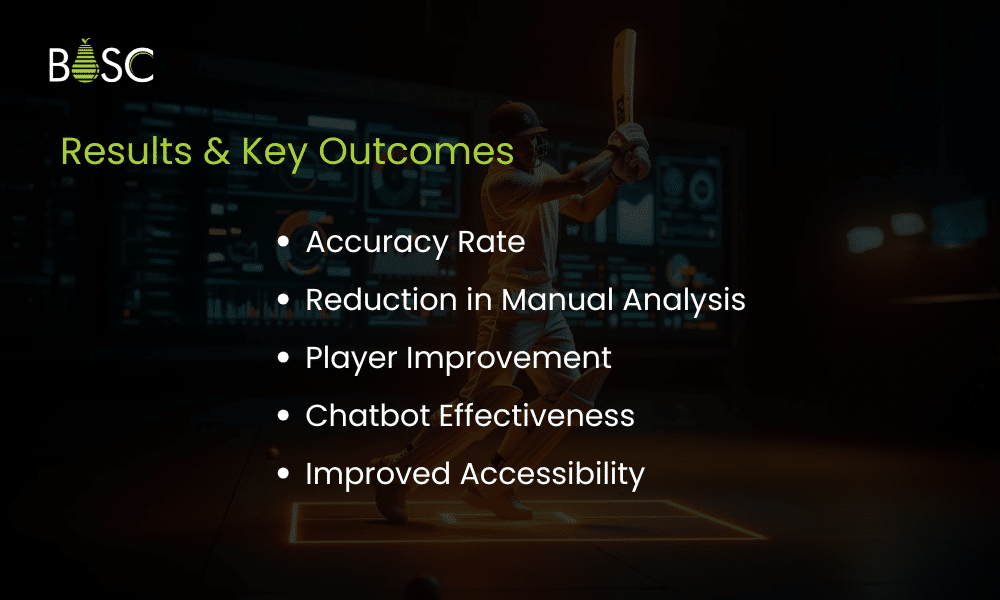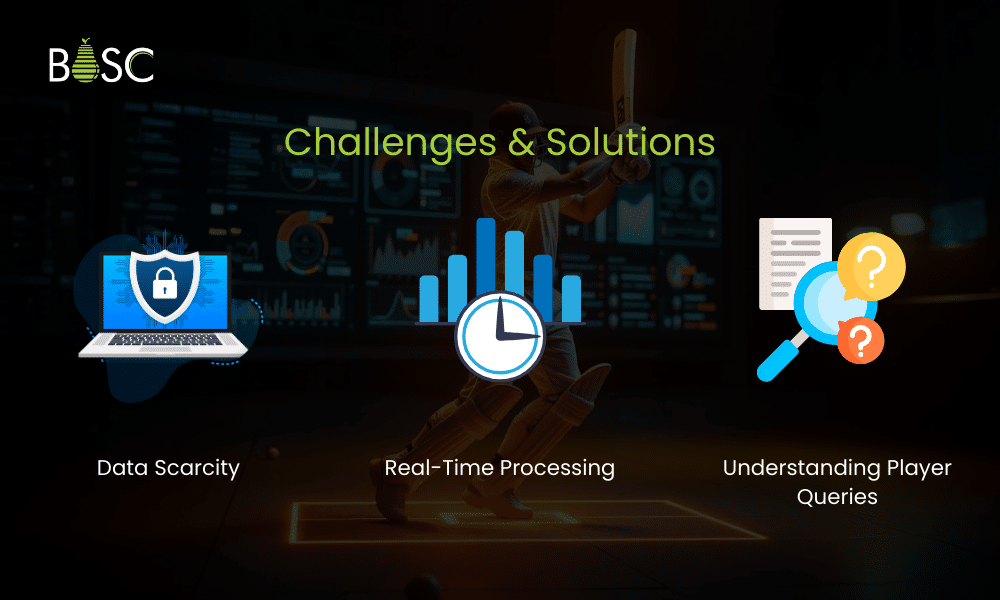Integrating AI into cricket training can open up many new opportunities. It particularly helps batsmen by providing phase-by-phase posture analysis. The tool first carefully notices every detail, right from the initial stance to the shot completion. After scanning this data, it provides instant feedback to the player. This feedback helps players understand their faults and rectify them to improve their performance. Besides real-time data, players also get personalized tutorials and a chatbot for immediate query resolution. Also, an AI Cricket coach makes elite coaching easily accessible to all, regardless of the location or the level of the player.
To rectify these mistakes, players have always relied on good cricket coaches. While it is quite effective, there are still lots of problems with this approach. For starters, it could be subjective and inconsistent. Also, there is always room for human error. For instance, the coach may not always spot every mistake. This is where a cricket AI Coach changes the game. With sports app development, a cricket AI coach can be created that provides a data-driven analysis of the player. The AI coach carefully observes every movement of the batsman and then prepares real-time feedback that can help the player look beyond just the basics.
You do not necessarily have to be a batsman to understand that batting requires an extraordinary degree of precision. Even a small mistake can affect your precision and lead to poor shot execution, like an incorrect foot placement or an off-balance follow-through.
This is where a cricket AI Coach changes the game. Using artificial intelligence, it provides a data-driven analysis of the player. The AI coach carefully observes every movement of the batsman and then prepares real-time feedback that can help the player look beyond just the basics.
Problems with Traditional Cricket Coaching
Did you know that maintaining proper batting posture is one of the most common problems players face? This is because a minor misstep during the stance or a lack of balance can seriously affect shot accuracy and power.
When trained by a human, the quality of your training completely depends on the observational skills of the coach. So, if the coach misses any details, the player receives wrong or delayed feedback. This could be problematic because players need immediate and specific guidance that addresses their weaknesses as they happen.
However, that is not the only issue. There are many other major problems with this approach as well. Expert-level coaching might just not be available to many players due to geographic or financial limitations. As a result, many players might not receive the guidance needed to improve their performance.
Unfortunately, you cannot completely separate these problems from this approach. Hence, the need of the hour is a real-time feedback system that can adapt to each player’s unique challenges. This is exactly where AI can make a real difference.
AI-Powered Posture Correction: The Solution
The Cricket AI Coach does much more than watching players — it analyzes their movements in real time. Here is how it works:
Real-Time Motion Tracking
Human eyes can miss out on a lot of details, but AI will not. AI’s computer vision can track every movement of a batsman. This includes each stage of the shot:
- Stance
- Backlift
- Shot execution
- Follow-through
From the head to the knees, the AI model first identifies specific markers on the player’s body. Then, it creates a 3D model of the batsman’s posture. As a result, the AI system could maintain a high level of accuracy and pinpoint even the smallest mistakes. Human coaches can never maintain the same level of accuracy.
Posture Classification and Correction
Each phase of the shot is classified as either:
- Correct: When the posture is perfect.
- Incorrect: If the posture is wrong, it could negatively affect the shot.
- Moderate: This means your posture is okay, but there is room for improvement.
Based on these classifications, the AI generates immediate feedback. For instance, if the system detects that a player’s head is not in line with the ball while playing the shot, it will immediately inform the batsman. Also, it shares feedback about how to rectify the mistake.
Personalized Learning Tutorials
The AI does not just highlight problems; it helps players improve. Based on the analysis, it suggests personalized tutorials designed to address the specific issues identified. These tutorials focus on drills or exercises that target weak points, such as improving balance during the stance or strengthening core stability for a better follow-through.
By constantly refining the player’s technique, the AI coach ensures continuous improvement over time.
Advanced AI Chatbot for Instant Support
In addition to real-time posture correction and tutorials, the Cricket AI Coach includes an AI-driven chatbot that acts as an on-demand assistant for players during practice.
The chatbot uses natural language processing (NLP) to interpret and respond to player queries conversationally. This makes it easy to ask for advice on the fly.
Its real-time interaction ensures that players receive instant feedback on specific cricket techniques or equipment-related questions. This feature is particularly helpful for solo practice sessions, as it bridges the gap when a coach is not available.
As players interact with the chatbot over time, it learns their preferences and offers more personalized answers.
Implementation Process
Building the Cricket AI Coach involved several planned stages. Each of these stages was critical to ensuring the AI system could deliver accurate feedback to cricketers.
Data Collection & Annotation
The foundation of any AI-driven system, especially those involving computer vision, lies in the quality of data used for training. Here is how we approached it:
Dataset Creation
The first step was to collect high-quality cricket batting footage. Our main focus was on the four critical phases of a shot: stance, backlift, downswing, and follow-through. We captured a wide variety of shots in different settings of each phase. This was essential to get different perspectives on elements like bat angle, foot movement, and body posture.
Annotation Process
Raw footage alone is not useful for training an AI model. Therefore, we needed to annotate the dataset to create a ground truth for training the model. All the key body points were marked to analyze the posture and movement. These included:
- Shoulders, elbows, and wrists to monitor arm movement.
- Head and neck to track balance and alignment with the ball.
- Knees, ankles, and feet for footwork analysis.
- Bat angle to ensure the correct trajectory during the downswing and follow-through.
We used specialized tools to plot these key points frame by frame so the AI could learn from highly accurate data.
Model Development
The next step was to design and train models capable of detecting and classifying the player’s movements. The AI system is composed of two main components: keypoint detection and posture classification.
Keypoint Detection Model
We used a modified version of YOLO (You Only Look Once) — a popular real-time object detection algorithm. YOLO is known for its ability to process images efficiently while retaining high accuracy. So, it is ideal for real-time applications like sports coaching.
If you are wondering why we chose YOLO, it is because YOLO is particularly suited for cricket. It allows the model to predict both the position of key points and confidence scores simultaneously. This ensures that the AI can detect body joints even during complex movements.
To adapt YOLO for cricket, we trained it specifically for keypoint detection on our annotated dataset. Key customization included:
- Fine-tuning the network architecture by adding layers optimized for joint and bat detection.
- Reducing the input size to speed up processing while maintaining accuracy.
- Using cross-entropy loss for precise keypoint prediction to minimize any discrepancy between predicted and actual positions.
The model was trained with a variety of optimization techniques like Adam optimizer with an initial learning rate, using a batch normalization layer to prevent overfitting and ensure generalization across different players and shot types.
Posture Classification Model
Once key points were detected, the next step was to classify each phase of the shot. For this, we developed a phase classification model using Convolutional Neural Networks (CNNs). This model was trained to recognize the four critical phases of a shot: stance, backlift, downswing, and follow-through.
The model also included a mechanism to classify each movement as correct, incorrect, or moderate, depending on its adherence to predefined technical parameters. These classifications were based on:
- Predefined biomechanical standards for each shot type.
- Comparative analysis against professional player data.
This phase classification model was built with Softmax output layers. It could predict the phase of the shot and posture accuracy (correct/incorrect/moderate) simultaneously.
Feedback & Correction Mechanism
Delivering accurate feedback is the essence of the AI coach. Here is how we designed the correction mechanism.
After classifying the posture, the system compares the detected movements with ideal biomechanical standards. For example, if the bat angle during the downswing deviates by more than a certain threshold, it flags the movement as incorrect.
The deviation is measured in degrees for body parts like the bat or arm and in millimeters for footwork.
Corrective Algorithms
We designed corrective algorithms that offer specific, actionable advice. So, when the system detects an imbalance in the follow-through, the feedback might suggest adjusting foot positioning to distribute weight more evenly.
The corrections are further customized based on the player’s history. If a player frequently makes the same mistake, the system will prioritize correcting that specific aspect of their technique.
Personalized Tutorials
The system does not just provide corrections; it offers tutorials based on the player’s recurring issues. These tutorials are dynamically generated and are aimed at improving specific aspects of a player’s game. For example:
If poor balance is detected, the system might recommend balance training drills.
If the player struggles with maintaining a consistent bat angle, it could suggest bat control exercises.
These recommendations are stored and updated as the player improves. This ensures that the advice remains relevant and progressive.
Chatbot Integration
We also integrated a chatbot to make the system more interactive and accessible. This is because we believe that it can completely change how the players interact with the AI coach. It was trained using large language models (LLMs) — advanced AI systems trained on huge amounts of text data. They were fine-tuned so that the focus remains on cricket-specific terminology.
So, if you ask questions like “How do I improve my follow-through?” or “What’s wrong with my backlift?”, it can easily understand them and answer correctly. You can ask for simple tips or proper in-depth explanations.
The real-time response by the AI coach ensures all queries are solved instantly. This is why it became an integral part of the player’s self-assessment process. Players could ask about specific movements or technique refinements at any time during practice sessions.
Deployment & Testing
After completing the development process, the AI system underwent rigorous testing. We very carefully examined every small aspect of it to ensure it could perform reliably in real-world scenarios.
Cloud-Based Deployment
We deployed the cricket AI coach on a cloud-based platform. It was done to support multiple users. The setup could process real-time data and ensure minimal delay when the players interacted with it.
Testing and Validation
The system had to be refined. To maintain complete accuracy, we used both professional cricketers and amateur players for the testing process. Our focus was mainly on:
- The feedback quality it provided
- Accuracy level when detecting posture
- And overall user experience of the players
Moreover, we established feedback loops so that the AI system’s performance can improve continuously.
Results & Key Outcomes
Here are the results we received when we used the AI coach in real-world scenarios:
Accuracy Rate
The system maintained an accuracy level of over 90% when detecting correct and incorrect postures. This high level of accuracy helps batsmen understand their mistakes and improve.
Reduction in Manual Analysis
Players no longer have to rely on human coaches for manual analysis. The automated process could allow coaches to focus more on strategies than technical corrections.
Player Improvement
The use of an AI system for posture correction and feedback helped players improve their stance, backlift, and shot execution.
Chatbot Effectiveness
The chatbot solved over 80% of the user queries in real time. This ensured instant feedback and solutions.
Improved Accessibility
With the help of an AI coach, players do not have to rely on a human coach at all times. It helped players train in the absence of a human coach, as well as provided feedback that helped in improvement.
Challenges & Solutions
While we can consider the Cricket AI Coach experiment a successful one, there are several challenges we encountered along the way. Our team managed to find a way through them and made it a success.
Data Scarcity
One of our biggest challenges or concerns was data scarcity. All AI models require sufficient data to train. So, if high-quality cricket datasets are not available, training the AI model will be difficult.
We solved this problem by creating a custom dataset. This included recordings of a large number of batting sequences. Since we want to design this for players of all levels, the recording was from both amateur and professional players.
Additionally, we applied transfer learning techniques. Pre-trained models from similar sports applications were taken and fine-tuned for cricket-specific tasks. It helped in maintaining the top level accuracy.
Real-Time Processing
Whether cricket or some other sport, real-time feedback is essential for improvement. And this was a big challenge for us.
To tackle this issue, we decided to optimize the model’s performance with efficient algorithms and use hardware acceleration in the cloud infrastructure. It ensured the players could receive feedback as soon as they played their shots.
Understanding Player Queries
Initially, when the chatbot was ready, it struggled a lot in understanding short, informal, or jargon-heavy queries from players. But it was a necessity to ensure user-friendliness.
So, we worked on the NLP models to make them better at handling these queries to recognize informal queries. The results were amazing- the model could now recognize shorthand phrases like “What’s wrong with my cover drive?” and provide answers.
Conclusion
The Cricket AI Coach could transform how players practice. Its instant posture correction, feedback, and interactive guidance can make all the difference when it comes to understanding and rectifying mistakes. Also, the fact that it makes training easily accessible to all players makes all the difference.
However, you will continue to witness many more improvements in the coming years. We believe AI-based shot analysis and integrating wearable sensor feedback can make a huge difference here.

